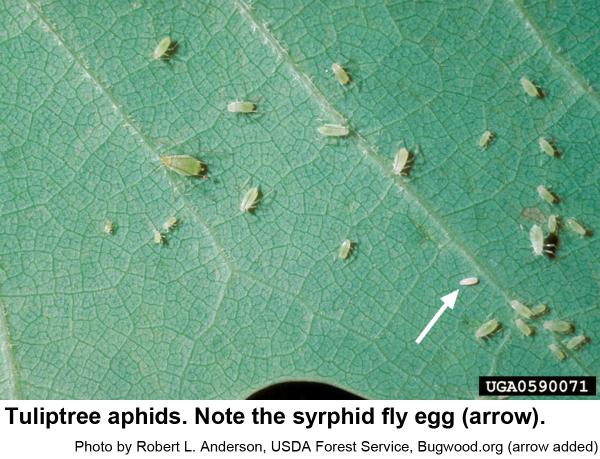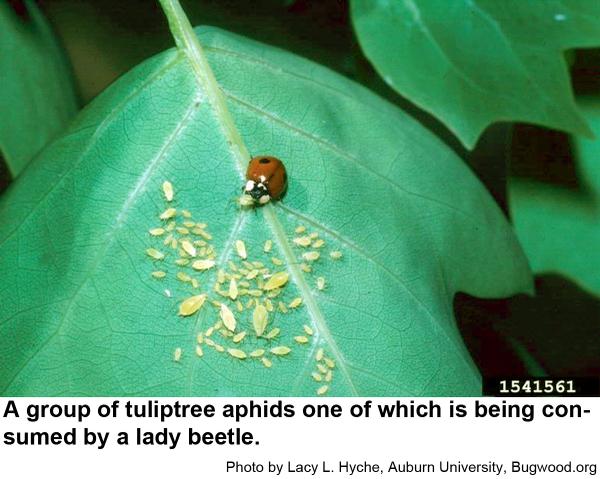Description and Biology
Wingless tuliptree aphids, Illinoia liriodendri, are spindle shaped and pale green to yellow, although some may be pinkish to red. The antennae are mostly black and are longer than the body. The legs are pale green merging to black near the feet. The cornicles (tube-like structures on the abdomen that resemble exhaust pipes on a hot rod) are black and long. These aphids grow to almost 1/8 inch long. Winged tuliptree aphids have translucent wings held roof-like over the greenish abdomen. The thorax and head are reddish to pale brown. During the spring and summer, females give birth to tiny, greenish nymphs that grow larger with each molt. Tuliptree aphids feed on undersides of the leaves. Dense populations can build up resulting in large deposits of honeydew on the leaves. Sexual forms occur in autumn and mate. Females lay overwintering eggs primarily in bark crevices near the buds. In spring the eggs hatch at bud break. Populations can build up rapidly on the leaves during the spring and summer.
Host Plants
Tulip tree is the only reported host plant for the tuliptree aphid. They may cause mild distortion of buds and foliage, and they excrete copious amounts of honeydew in which sooty molds grow. Honeydew dripping on pavement and parked cars below is a nuisance as are the flies and wasps attracted to the honeydew.
Residential Recommendations
Tuliptree aphid populations increase dramatically because they reproduce parthenogenetically and because they fly into new areas from time to time. In warm weather, parasitic wasps, lady beetles, syrphid fly maggots, lace wings and other predaceous insects feed on aphids so that aphid populations often decrease rapidly as well. When the weather is hot and damp, aphid populations are sometimes devastated by Cephalosporium lecanii, a fungus that infects aphids as a sort of fatal athlete's foot disease. In the case where natural controls have failed to keep up with the aphids, and if the tulip tree is small enough to spray, an insecticide should give adequate control. Water the tree thoroughly before spraying if the weather has been dry. Spray early in the morning or in the evening so that the pesticide residue is dry before the plant is exposed to direct sunlight. Insecticidal soaps or horticultural oils give adequate control of aphids although a number of other pesticides are labeled for aphids that should also give adequate control as well. Soaps and oils are less damaging to parasites and predators than are most other types of insecticides.
Other Resources
- Aphids on Ornamental Landscape Plants. Frank, S. 2009. Entomology Insect Notes, NC State Extension Publications.
- Illinoia liriodendri, Tulip-tree aphid. Anonymous. No Date. InfluentialPoints.com.
- Integrated pest management of tuliptree aphids. Dreistadt, S. H. et al. No Date. University of California, Division of Agriculture and Natural Resources.
- Tuliptree Aphid. Cloyd, R. 1999. Home, Yard & Garden Pest Newsletter, University of Illinois Extension.
- Extension Plant Pathology Publications and Factsheets
- Horticultural Science Publications
- North Carolina Agricultural Chemicals Manual
For assistance with a specific problem, contact your local N.C. Cooperative Extension Center.
This Factsheet has not been peer reviewed.
Publication date: June 7, 2019
Reviewed/Revised: March 25, 2024
Recommendations for the use of agricultural chemicals are included in this publication as a convenience to the reader. The use of brand names and any mention or listing of commercial products or services in this publication does not imply endorsement by NC State University or N.C. A&T State University nor discrimination against similar products or services not mentioned. Individuals who use agricultural chemicals are responsible for ensuring that the intended use complies with current regulations and conforms to the product label. Be sure to obtain current information about usage regulations and examine a current product label before applying any chemical. For assistance, contact your local N.C. Cooperative Extension county center.
N.C. Cooperative Extension prohibits discrimination and harassment regardless of age, color, disability, family and marital status, gender identity, national origin, political beliefs, race, religion, sex (including pregnancy), sexual orientation and veteran status.


